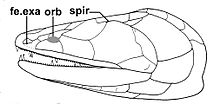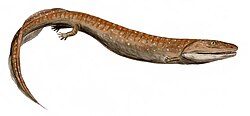| Cabonnichthys Temporal range: Late Devonian | |
|---|---|
 | |
| Skull and shoulder-girdle restorations. left lateral view of Cabonnichthys burnsi | |
| Scientific classification | |
| Domain: | Eukaryota |
| Kingdom: | Animalia |
| Phylum: | Chordata |
| Clade: | Sarcopterygii |
| Clade: | Tetrapodomorpha |
| Clade: | Eotetrapodiformes |
| Family: | † Tristichopteridae |
| Genus: | † Cabonnichthys Johanson & Ahlberg, 1997 |
| Species: | †C. burnsi |
| Binomial name | |
| †Cabonnichthys burnsi Johanson & Ahlberg, 1997 | |
Cabonnichthys ("Burns' Cabonne fish") is an extinct genus of tristichopterid fish that lived in the Late Devonian period (Famennian) of Australia. It has been found in Canowindra and is a medium-sized carnivorous lobe-finned fish. [1]





